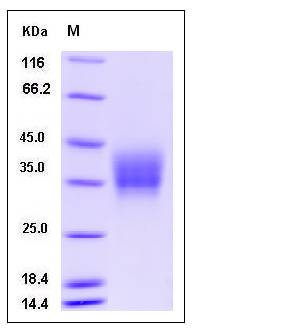Mouse Oncostatin M / OSM Protein (His Tag)
OncoM
- 100ug (NPP3433) Please inquiry
| Catalog Number | P50112-M08H |
|---|---|
| Organism Species | Mouse |
| Host | Human Cells |
| Synonyms | OncoM |
| Molecular Weight | The secreted recombinant mouse OSM comprises 193 amino acids and has a calculated molecular mass of 22 kDa. As a result of glycosylation, the apparent molecular mass of the recombinant protein is approximately 35-40 kDa in SDS-PAGE under reducing conditions. |
| predicted N | Asn 25 |
| SDS-PAGE |  |
| Purity | > 95 % as determined by SDS-PAGE |
| Protein Construction | A DNA sequence encoding the mature form of mouse OSM (P53347) (Met 1-Arg 206) was expressed, with a C-terminal polyhistidine tag. |
| Bio-activity | 1. Measured by its ability to inhibit proliferation of M1 mouse myeloid leukemia cells. The ED50 for this effect is typically 50-200 ng/mL. 2. Measured in a cell proliferation assay using NIH3T3 cells. The ED50 for this effect is typically 0.8-4 ng/mL. |
| Research Area | Cancer |Cancer immunology |Cytokine & Receptor |Interleukin & Receptor |IL-6 family & Receptor |IL-6 family ligand | |
| Formulation | Lyophilized from sterile PBS, pH 7.4 1. Normally 5 % - 8 % trehalose and mannitol are added as protectants before lyophilization. Specific concentrations are included in the hardcopy of COA. |
| Background | Oncostatin M (OSM) is a glycoprotein belonging to the interleukin-6 family of cytokines that has functions mainly in cell growth. Oncostatin M (OSM) is considered as a pleiotropic cytokine that signals through cell surface receptors typeⅠand typeⅡ both of which share the similarity of containing protein gp130 and takes part in many biometabolism processes including liver development, haematopoeisis, inflammation, bone formation and destruction and possibly CNS development. Oncostatin M (OSM) was previoustly identified by its ability to inhibit the growth of cells from melanoma and other solid tumors. It also has been reported that OSM, like LIF, IL-6 and G-CSF, has the ability to inhibit the proliferation of murine M1 myeloid leukemic cells and can induce their differentiation into macrophage-like cells. The human form of OSM is insensitive between pH2 and 11 and resistant to heating for one hour at 56 degree but is not stable at 90 degrees. The human OSM is produced as a precursor containing 252 amino acids, whose first 25 amino acids function as a secretory signal peptide and which on removal yields the soluble 227 amino acid pro-OSM. Removal of the C-teminal most 31 amino acids produces the fully active 196 residue form. |
| Reference |
